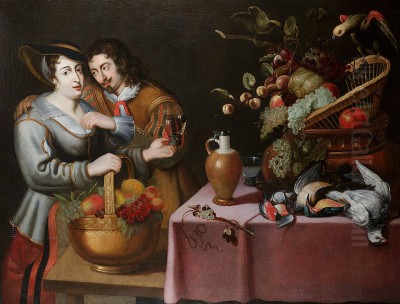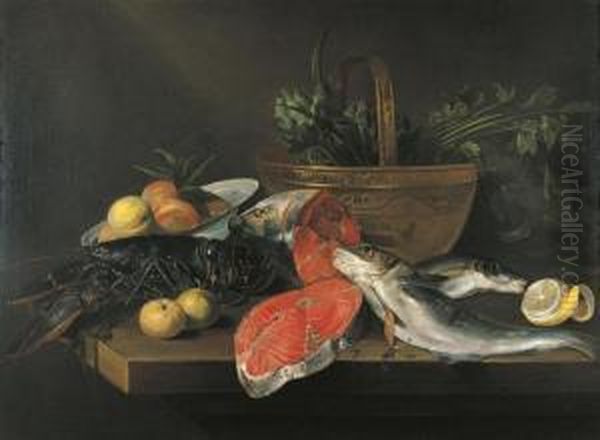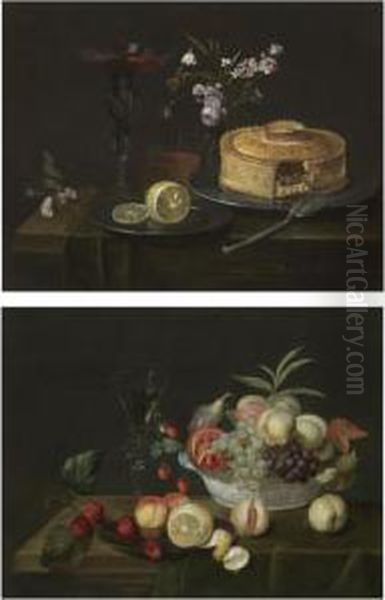
Frans Ykens (1601–1693) stands as a significant figure in the rich tapestry of 17th-century Flemish art, a period often referred to as the Golden Age of painting in the Southern Netherlands. Born in Antwerp, a bustling metropolis and a vibrant artistic hub, Ykens carved a distinguished career primarily as a painter of still lifes, contributing prolifically to genres that captivated patrons and fellow artists alike. His oeuvre, characterized by meticulous detail, vibrant palettes, and often imbued with subtle symbolism, reflects both the artistic currents of his time and his unique sensibility.
Early Life and Artistic Formation in Antwerp
Frans Ykens was baptized in Antwerp on April 17, 1601. His artistic journey began under the tutelage of his uncle, Osias Beert the Elder (c. 1580–1623/24), a pioneering figure in the development of still life painting in Flanders. Beert was renowned for his "breakfast pieces" (ontbijtjes) and flower still lifes, typically arranged on a high viewpoint, showcasing objects with a jewel-like precision. This early training with such a distinguished master undoubtedly laid a strong foundation for Ykens, instilling in him a deep appreciation for the careful observation of nature and the refined rendering of textures.
Antwerp, during Ykens's formative years, was a crucible of artistic innovation. The city was home to towering figures like Peter Paul Rubens (1577–1640) and Anthony van Dyck (1599–1641), whose dynamic Baroque style influenced nearly every facet of artistic production. While Ykens specialized in a different genre, the prevailing artistic climate, with its emphasis on richness, dynamism, and technical virtuosity, would have inevitably shaped his approach. The Guild of Saint Luke, Antwerp's powerful artists' guild, regulated training and professional practice, ensuring high standards of craftsmanship.
Travels and Maturation as a Master

Around 1629, Ykens embarked on a journey to France, a common practice for ambitious artists seeking to broaden their horizons and study different artistic traditions. He is documented in Aix-en-Provence and Marseille. Such travels often exposed artists to new patrons, stylistic influences, and subject matter. Upon his return to Antwerp, Ykens's skill and reputation had evidently grown, as he was registered as a master in the Guild of Saint Luke in 1630. This status allowed him to establish his own workshop, take on pupils, and sell his works independently.
His artistic style began to mature, absorbing various influences while retaining a personal touch. While the meticulousness of Beert remained, Ykens's compositions often became more complex and his palette sometimes richer, reflecting the evolving tastes of the Baroque era. He became known for a broad, yet controlled, brushstroke and a delicate application of color that brought his subjects to life with remarkable verisimilitude.
Specializations in Still Life Painting
Frans Ykens demonstrated remarkable versatility within the still life genre, excelling in several sub-categories that were popular during the 17th century.
Flower Paintings
Flower still lifes were immensely popular, prized for their decorative beauty and often laden with symbolic meaning. Ykens produced numerous exquisite flower pieces, showcasing a wide variety of blooms, from common garden flowers to exotic rarities like tulips, which were then a subject of intense speculation and admiration. These paintings were not mere botanical studies; they were carefully composed arrangements designed to delight the eye and often to convey deeper messages. For instance, roses might symbolize love or, in a religious context, the Virgin Mary; lilies could represent purity; and tulips, with their ephemeral beauty, could allude to the transience of life. His Still Life with Roses, Tulips and Carnations in a Glass Vase is a fine example, where the delicate rendering of petals and leaves, and the play of light on the glass, showcase his technical mastery.
Fruit Still Lifes and Banquet Pieces
Ykens also excelled in depicting luscious arrangements of fruit, often combined with ornate vessels, glassware, and sometimes game or seafood. These works, known as pronkstilleven (ostentatious still lifes), celebrated abundance and material wealth. Artists like Jan Davidsz. de Heem (1606–1684), who was active in both Antwerp and Utrecht, and the Dutch painter Willem Kalf (1619–1693), were masters of this opulent genre, and Ykens contributed significantly to its Flemish expression. His Fruit Piece compositions would typically feature a cornucopia of grapes, peaches, cherries, and other fruits, rendered with a palpable sense of texture and ripeness. These, too, could carry symbolic weight: grapes often alluded to Christ and the Eucharist, while peaches could symbolize truth or salvation.
Garland Paintings

A particularly distinctive Antwerp speciality was the "garland painting" (guirlandes). This genre typically involved a central image – often a religious scene, a portrait, or a sculpted cartouche – surrounded by an elaborate wreath or festoon of flowers and fruits. These were frequently collaborative efforts, with a figure painter creating the central motif and a still life specialist, like Ykens, meticulously rendering the surrounding natural elements. Daniël Seghers (1590–1661), a Jesuit lay brother and a pupil of Jan Brueghel the Elder (1568–1625), was a leading exponent of this genre, and Ykens was clearly influenced by him, producing many such works. An example is his Garland around Madonna, where the devotional image is framed by a vibrant and meticulously detailed floral border. Other figure painters who collaborated on such pieces included Cornelis Schut (1597–1655) and Thomas Willeboirts Bosschaert (1613–1654). The flowers and fruits in these garlands were not merely decorative; they often held specific symbolic meanings related to the central scene, enhancing its devotional or allegorical message.
Kitchen and Market Scenes
Ykens also painted kitchen and market scenes, a genre popularized by artists like Frans Snyders (1579–1657) and Adriaen van Utrecht (1599–1652). These compositions often featured an abundance of game, fish, vegetables, and fruit, sometimes with figures preparing food or selling wares. His Kitchen Still Life with Christ in the House of Mary and Martha is a fascinating example, combining a lavish display of foodstuffs in the foreground with a biblical narrative in the background. This integration of genre elements with religious themes was a common characteristic of Flemish Baroque art, allowing for moral instruction to be conveyed through scenes of everyday life or opulent displays.
Vanitas Symbolism
Underlying many of Ykens's still lifes, particularly his flower pieces and banquet scenes, is the theme of vanitas. This concept, derived from the biblical Book of Ecclesiastes ("Vanity of vanities, all is vanity"), reminded viewers of the transience of earthly life, the futility of worldly pleasures, and the inevitability of death. Wilting flowers, overripe fruit, decaying game, and the presence of insects like flies (symbolizing decay) or butterflies (symbolizing the resurrected soul) all served as subtle or overt reminders of mortality. Even the most opulent displays of wealth and beauty were thus tinged with a melancholic awareness of their fleeting nature, encouraging contemplation of spiritual matters. This was a prevalent theme in the art of the Low Countries, seen in the works of artists like Harmen Steenwijck (c. 1612–c. 1656) in Holland and even in the more exuberant Flemish compositions.
Technique and Style
Ykens's technique was characterized by a combination of meticulous detail and a fluid, confident brushwork. He had a keen eye for texture, masterfully rendering the velvety softness of a peach, the delicate translucency of a grape, the cool sheen of metal, or the fragile beauty of a flower petal. His use of color was often vibrant and harmonious, with rich hues balanced by subtle gradations of light and shadow that created a sense of volume and depth. While influenced by the precision of early Flemish still life painters like Osias Beert and Jacob van Hulsdonck (1582–1647), Ykens's style also embraced the more dynamic and painterly qualities of the High Baroque. His compositions, though carefully arranged, often possess a sense of naturalism and an inviting tactile quality.
Collaborations and Contemporaries
The Antwerp art scene was highly collaborative. As mentioned, Ykens likely collaborated with figure painters for his garland paintings. He was also part of a broader community of still life specialists. Besides his teacher Osias Beert and the influential Daniël Seghers, other notable contemporaries in Antwerp specializing in still life included Clara Peeters (1594–c. 1657), one of the few prominent female painters of the era, known for her detailed breakfast pieces, and Jan Fyt (1611–1661), who excelled in hunting still lifes and animal paintings. The exchange of ideas and motifs was common, leading to a vibrant and evolving tradition.
Ykens's wife, Catarina Ykens-Floquet (1608/1618 – after 1666), was also a painter, specializing in similar subjects, particularly fruit and flower garlands. She was the daughter of the painter Lucas Floquet I and sister to three painters. It is highly probable that Frans and Catarina collaborated on works, a common practice in family workshops of the period. This artistic partnership would have further enriched their creative environment.
Patronage and Recognition
Ykens achieved considerable success during his lifetime. His works were sought after by collectors and patrons, both locally and internationally. Notably, his paintings were found in the collections of prominent figures such as Archduke Leopold Wilhelm of Austria, Governor of the Spanish Netherlands and an avid art collector, and even the great Peter Paul Rubens himself is said to have owned works by Ykens. This level of patronage attests to the high regard in which his art was held. His paintings found their way into collections across Europe, contributing to the widespread appreciation of Flemish still life.
Later Career and Brussels Period
In 1665, Ykens moved to Brussels, where he continued to be active as a painter. Brussels, though perhaps not as dominant an artistic center as Antwerp at that specific time, still offered opportunities for artists. He is documented as residing there until at least 1667, though some sources suggest a longer stay. The reasons for his move are not entirely clear but could have been related to patronage opportunities or other personal factors. He eventually returned to Antwerp, where he is believed to have spent his final years.
The exact date of his death has been subject to some scholarly debate. While traditionally cited as 1693 in Antwerp, some art historians have suggested he may have lived longer, possibly until 1705. This uncertainty is partly due to the fact that many of his works are undated, and his later life is less well-documented than his earlier, highly productive period in Antwerp.
Legacy and Museum Collections
Frans Ykens left behind a substantial body of work that continues to be admired for its technical skill, aesthetic beauty, and rich symbolism. He played an important role in the development and popularization of various still life subgenres in Flanders. While perhaps not as revolutionary as some of his contemporaries, his consistent quality and prolific output solidified his reputation as a master of his craft.
His paintings are now held in the collections of numerous prestigious museums around the world, a testament to their enduring appeal. These include:
The Prado Museum, Madrid
The Hermitage Museum, St. Petersburg
The Kunsthistorisches Museum, Vienna
The Royal Museums of Fine Arts of Belgium, Brussels
The Museum of Fine Arts, Ghent
Various museums in Berlin
The National Museum, Warsaw
The Mauritshuis, The Hague (though attribution can sometimes be complex)
The presence of his works in these institutions allows contemporary audiences to appreciate his contribution to the golden age of Flemish painting. His art provides a window into the cultural values, aesthetic preferences, and symbolic language of the 17th century.
The Enduring Appeal of Frans Ykens
Frans Ykens's contribution to art history lies in his mastery of still life painting, a genre that reached unprecedented heights in 17th-century Flanders. He skillfully blended meticulous observation with artistic invention, creating works that were both visually stunning and intellectually engaging. His flower pieces capture the ephemeral beauty of nature, his banquet scenes celebrate abundance while hinting at its transience, and his garland paintings frame devotion with natural splendor.
As a student of Osias Beert and a contemporary of giants like Rubens and Seghers, Ykens navigated the dynamic Antwerp art world with skill and creativity. He absorbed influences, developed a personal style, and contributed to the rich tradition of Flemish Baroque art. His collaborations, including those with his wife Catarina Floquet, highlight the interconnectedness of the artistic community. The patronage he received from notable collectors underscores the high esteem in which his work was held.
Today, Frans Ykens is recognized as a significant and highly accomplished practitioner of still life. His paintings continue to fascinate viewers with their intricate detail, vibrant colors, and the subtle interplay of realism and symbolism, securing his place as a distinguished master in the annals of European art. His legacy is not just in the individual canvases he produced, but in his embodiment of the dedication to craft and the profound engagement with the visual world that characterized the best of Flemish painting.